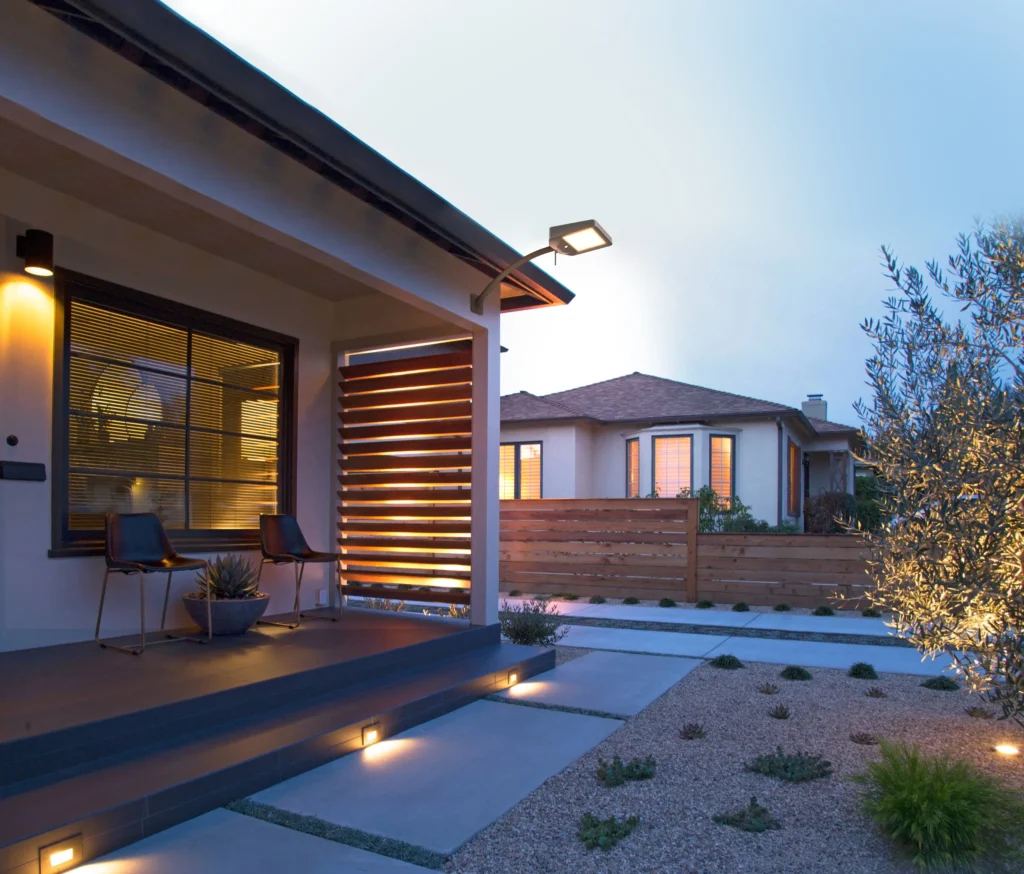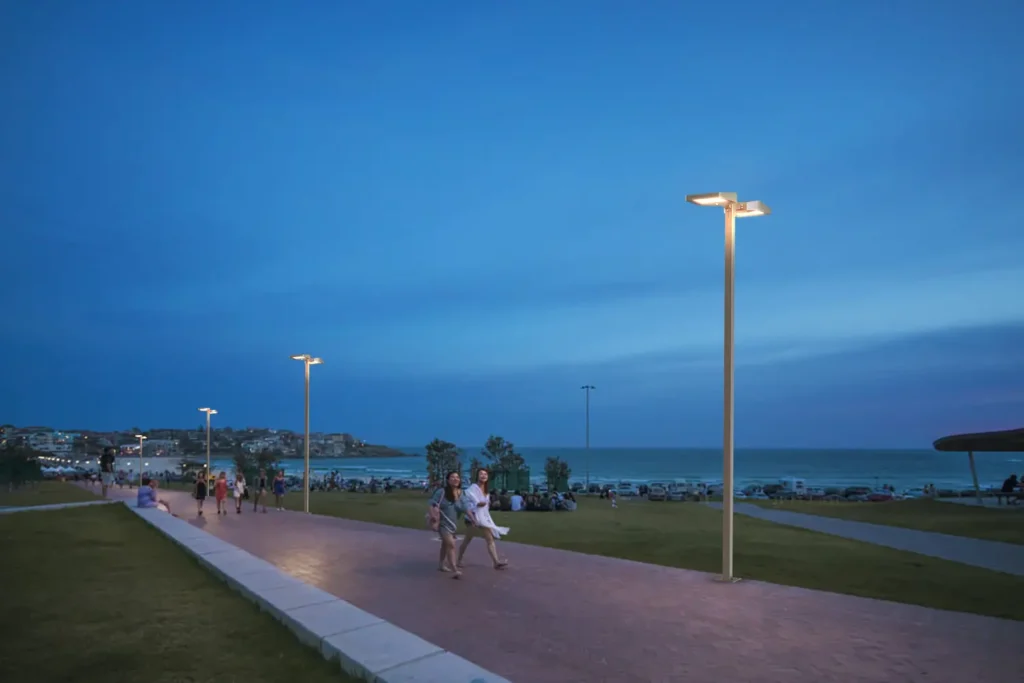With the acceleration of urbanization, residential lighting design has become an essential means to improve the quality of life for residents, ensure safe travel, and save energy while reducing emissions. This article will be based on the “Urban Road Lighting Design Standards,” providing a detailed description of residential lighting solutions, designed to help readers understand the various aspects of lighting design.

Safety Lighting Design: Ensuring Worry-Free Nighttime Travel
Safety lighting design is the primary task of residential lighting design. In terms of road lighting, the spacing and height of street lights should be set reasonably according to factors such as road width, traffic flow, and pedestrian flow. Main and secondary roads usually adopt high-pole lighting or conventional lighting to ensure that vehicles and pedestrians can clearly see the road ahead and avoid traffic accidents. Sidewalks can use cut-off light fixtures or semi-cut-off light fixtures to reduce glare, improve lighting quality, and ensure pedestrian safety.
Stairwell Lighting Design:
Stairwells, as daily access points for residents, are particularly important for lighting design. The appropriate brightness of lamps should be chosen to ensure that residents can clearly see the steps when going up and down, preventing accidents. Additionally, stairwell lighting design should also consider emergency lighting facilities to ensure that necessary lighting is automatically provided during power outages or emergencies.
Parking Lot Lighting Design:
Parking lot lighting design needs to consider the vehicle’s trajectory and parking position to avoid glare while ensuring that the vehicle and the surrounding environment are clearly visible. Uniformly distributed lighting fixtures should be used to ensure that the light distribution in the parking lot is even, improving the lighting effect.

Environmental Lighting Design: Creating a Warm and Comfortable Living Environment
Environmental lighting design aims to create a warm and comfortable living environment. In residential areas such as green belts, water systems, and leisure plazas, landscape lighting can be used for decoration. Buried lights and floodlights are common landscape lighting equipment, which can illuminate trees and flowers to enhance their nighttime aesthetic appeal. Additionally, the facades of residential buildings can be designed with lighting to emphasize the outline and characteristics of the buildings, enhancing the overall image of the residential area.
In environmental lighting design, the choice of color and color temperature should be considered. Soft warm light sources can create a warm and comfortable atmosphere, allowing residents to feel the warmth of home at night. It is also necessary to avoid excessive lighting and light pollution to ensure that residents can enjoy the beautiful night scenery without unnecessary interference.

Intelligent Lighting System: Achieving Intelligent Management and Energy Saving
Intelligent lighting systems are an essential component of modern residential lighting design. By incorporating an intelligent lighting system, it is possible to achieve not only remote control of lighting fixtures but also automatic adjustments of brightness and duration of light exposure. Additionally, these systems introduce a variety of state-of-the-art technological features.
- Advanced Connectivity: Mesh 5.0 Bluetooth technology offers a reliable and potentially interconnected system for lights. This technology enables a stable network to be formed between lighting devices, allowing seamless connectivity and communication between them. Additionally, Mesh 5.0 Bluetooth technology supports integration with smart home systems, enabling lights to be linked with other smart devices (e.g., security systems, curtains, audio, etc.) for a smarter home living experience.
- Intuitive Control Options: Residents can easily control the lights through a dedicated app and CdS (cadmium sulfide) sensors. The app features an intuitive user interface that allows residents to adjust the light’s brightness, color temperature, and other parameters anytime, anywhere, to create personalized lighting scenarios. On the other hand, the CdS sensor detects the ambient light level in real time and automatically adjusts the brightness of the lights to ensure that indoor lighting is always maintained at a comfortable level. This intelligent adjustment function not only facilitates residents’ use but also helps save energy and achieve green lighting.

Energy Saving and Environmental Protection Measures: Green Lighting, Protecting the Earth
In residential lighting design, the application of energy-saving and environmental protection measures is crucial. First, high-efficiency, energy-saving light sources such as LED should be prioritized. LED lamps have high luminous efficiency, long life, and are environmentally friendly, significantly reducing lighting energy consumption. They also offer better dimmability and controllability, facilitating intelligent management and energy-saving control.
Secondly, in areas such as courtyards and leisure plazas, solar street lights can be installed. Solar street lights use solar energy to generate electricity without the need for laying cables, offering the advantages of energy saving, environmental protection, and easy installation. With sufficient sunlight, solar street lights can automatically charge and store electricity for nighttime use.
Additionally, lighting design should comply with national and local energy-saving standards. An intelligent control system can be used for automatic adjustment of lighting brightness and time according to time, weather, and foot traffic to achieve energy saving and emission reduction. When selecting lamps, high-efficiency, energy-saving products should be used to reduce energy consumption and waste.

Lighting Design and Humanized Care
Lighting design is not only about brightness and energy saving but also about humanized care. In residential lighting design, it is necessary to fully consider residents’ living habits, visual comfort, and psychological needs.
- Color Temperature and Brightness:The choice of color temperature and brightness directly affects people’s visual experience. Different areas and occasions in residential areas require different color temperatures and brightness levels. For example, on main and secondary roads, a higher brightness and cooler color temperature (such as 5000K-6500K) can be chosen to provide sufficient lighting and clear road information. In leisure plazas and green belts, lower brightness and warmer color temperatures (such as 3000K-4000K) can be selected to create a warm and comfortable atmosphere.
- Anti-glare Design:Glare can affect visual comfort and potentially lead to traffic accidents. Therefore, in residential lighting design, special attention should be paid to anti-glare design. For instance, lamps with anti-glare functions can be chosen, and the installation of lamps should consider adjusting the angle and height to avoid direct light into the eyes of pedestrians and drivers.
- Lamp Modeling and Material:Lamp modeling and materials are also important in lighting design. In residential areas, lamp designs should be coordinated with the architectural style, being both aesthetically pleasing and practical. The materials used for lamps should have good weather and corrosion resistance to ensure durability without rust or damage.
Summary and Prospect:
With the acceleration of urbanization and the improvement of residents’ living standards, the importance of lighting design in residential areas is increasingly prominent. Through reasonable lighting design, not only can the residents’ quality of life and sense of security be improved, but also the goal of energy saving and emission reduction can be achieved. Based on the Urban Road Lighting Design Standard, this paper provides an in-depth analysis of residential lighting solutions, detailing safety lighting design, environmental lighting design, intelligent lighting systems, energy-saving and environmental protection measures, as well as humanized care.
In the future, as science and technology continue to advance and environmental awareness improves, residential lighting design will focus more on being intelligent, green, and humanized. Advanced sensing and artificial intelligence technologies can be used for more intelligent lighting control. More environmentally friendly materials and light sources can reduce energy consumption and environmental pollution. Lighting design can also be used to create a more diverse and personalized living environment.
In conclusion, residential lighting design is a complex and important task. Through reasonable lighting design and intelligent management, a safe, comfortable, energy-saving living environment can be created, enhancing the quality of life for residents.